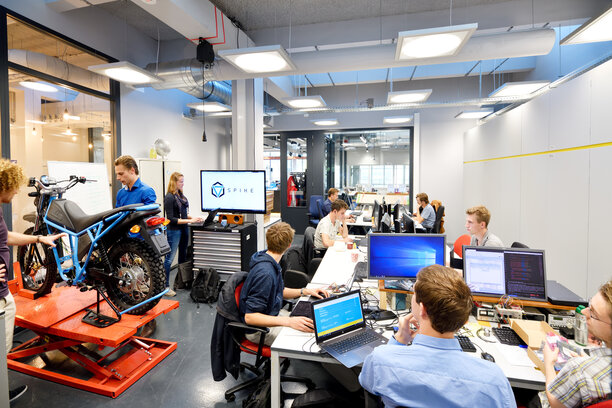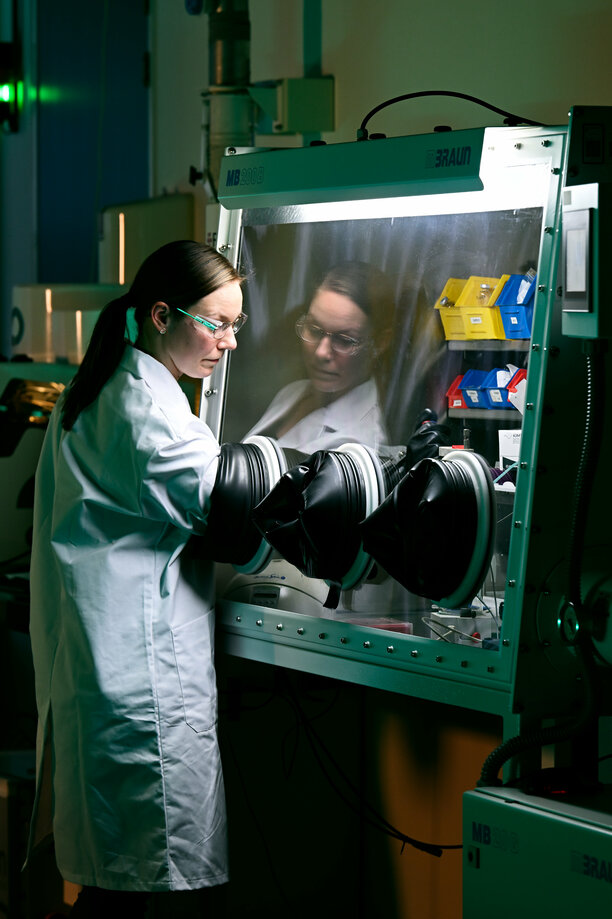'The university also needs to play an active role in society'
For Rector Silvia Lenaerts, the innovation ecosystem was one of the reasons for choosing Eindhoven.
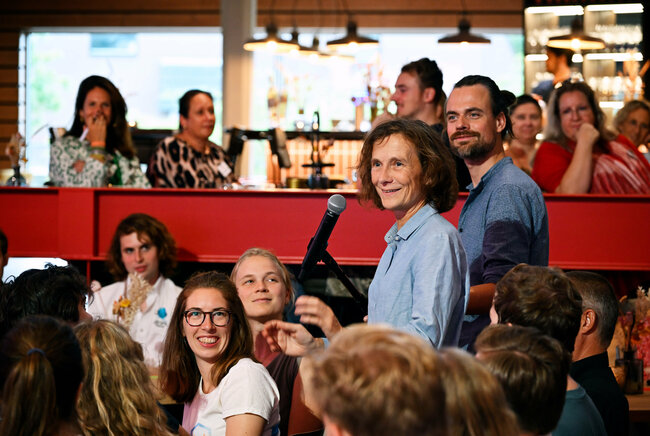
Eindhoven University of Technology - like most universities - is proud of its achievements in education and research. But for every university, and certainly for TU/e, valorization is the third core task. This is about making an impact on society by using the knowledge of scientific research to create something valuable for society. Rector Silvia Lenaerts (1966) on why bridging the gap between academic knowledge and societal applications is crucial. She shows us the role The Gate and Brainport Eindhoven's innovative ecosystem play in this.
For Lenaerts, who took office last May as Frank Baaijens' successor, that ecosystem was one of the reasons for choosing Eindhoven. At her prior university, in Antwerp, she had also shown herself in full force as the administrator who tried to enthuse her academic colleagues and students to look outside the walls of the alma mater. Since 2016, as the Vice Rector of Valorization & Development in Antwerp, she has been the booster and connector of the innovation ecosystem.
Although she got quite a lot done in that role, she already knows that Eindhoven has much more to offer in this important area. "In Antwerp, I always had to to apply tremendous effort; here in Eindhoven, it fits completely into the culture, and the processes are also more geared to it."

Valorisation fits completely into the Eindhoven culture
Rector Silvia Lenaerts
Steer and strengthen
Unlike in Flanders, Eindhoven thrives on a proactive, results-oriented culture, Lenaerts notes. In doing so, she plans to use her role as a rector not only to steer the academic direction of the university but also to strengthen the symbiotic relationship with society and business.
After all, the Brainport region is home to many high-tech companies that work closely with the university. ASML, which last year announced an investment of several hundred million euros to build and operate new research facilities within the walls of the TU/e, is the most appealing example. However, there are also great collaborations with companies such as Thermo Fischer, ASM, VDL, and DAF.
Excellence
As if to take the wind out of the sails of the skeptics, the rector emphasizes it several times during our conversation: no matter how vital valorization is, it should never come at the expense of the "academic excellence" that both staff and students and the outside world can expect from her institute.
"So when I talk about a gradual culture change to place even more emphasis on our role in social and economic value creation, this is not an attack on basic research. On the contrary, research is an essential foundation for valorization."
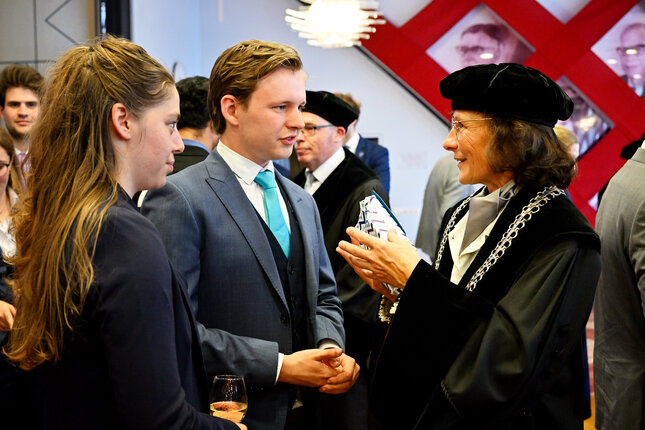
Valorization is part of everyone's job description, but as far as I'm concerned, everyone can fill that task in their own way.
Rector Silvia Lenaerts
In Antwerp, Lenaerts focused on three areas: metropolitanization, sustainable chemistry and infectious diseases. A number of solid domains are also emerging for Eindhoven. In close connection with the four research institutes the TU/e has developed in recent years (EIRES for sustainable energy, ICMS for materials and molecular systems, EHCI for electronics, photonics, and quantum, and EAISI for artificial intelligence), she is going to entice her staff further to explore valorization and collaboration in addition to excellent research.
"Valorization is part of everyone's job description, but as far as I'm concerned, everyone can fill that task in their own way. For example, for some, that means a guest lesson in Studium Generale; for others, it’s the establishment of their own company. In the annual performance reviews, we keep track of their progress."
Societal challenges
Lenaerts wants to move from "the hard technology push" to an approach that considers societal challenges. "Suppose there is a problem, for example, in health care, in air pollution, or in energy storage. We should then immediately ask ourselves how we can create collaborations to solve this, using our knowledge and thus contribute to the systemic or technological solution of the problem."
To make that happen, spinoffs and start-ups are essential. “After all, they are pre-eminently the tools to connect technological innovation with addressing societal challenges. There's a beautiful work of art here entitled ‘Where innovation starts’ for a reason.”
The Gate
Lenaerts calls The Gate the ideal intermediate station for her valorization mission for two reasons: "First, with their growing portfolio of spinoffs and supported start-ups, they show exactly how the principle of tech transfer works. In addition, they are the ideal connection to the local ecosystem through their partnerships with Fontys, Summa, BOM, Brainport and the municipality. The Gate is much further along in this than similar organizations at other universities, also thanks to the way in which cooperation takes place in this region."
Although currently located on the TU/e campus, Lenaerts likes to see The Gate as a place where the entire Brainport region is welcome. This is done, for example, through informative events for start-ups and consultation hours where the alderman for economic affairs is also present, but also by The Gate itself occasionally holding offices at one of the partners.
"In most countries, technology transfer is set up purely as something in the university. Too often, they just try to push something to society which doesn't always need it. Here, The Gate was set up as a collaboration with Fontys, Summa, Brainport, BOM, the municipality and the university. And that's great, because then you actually have all these different stakeholders along to get something substantial done in the ecosystem."
Only together
Her enthusiasm about The Gate does not mean that everything is perfect. "The cooperation with Fontys and Summa still needs to be strengthened. Because we need every talent. It is not only about the university-educated engineers but also the students from MBO and HBO who are more practically inclined. Only together will we get to where we want to be."

The cooperation with Fontys and Summa still needs to be strengthened. Because we need every talent.
Rector Silvia Lenaerts
Barriers
Lenaerts understands that there are certain barriers, for example for a Summa student or employee to approach the university. But she also sees options to break them. "It is, indeed, quite difficult to find access to the university. That's why I think locations do matter. Just look at the Automotive Campus: if our student teams are working there, and students from Fontys and Summa are there as well, they can also hook up more easily. So we have to use those co-locations on both sides actively."
"We have already shown this in automotive, but it can also work in ICT. And it goes further. What I saw on a trade mission in the US, for example - and I have already passed this on to Summa - is a very low-threshold recruitment of students interested in the chip industry. They can then get an entry through a 10-day course and from there they move on to other courses. So there are plenty of opportunities in education as well."
Culture
Culture can be both stimulating and limiting in regard to the effectiveness of valorization, Lenaerts acknowledges. "Culture matters. For us, that means that academic values are paramount. There has to be academic freedom but also collaboration, fellowship, diversity, inclusion, and integrity. Especially in an entrepreneurial university like ours, the academic foundation is essential."
Embrace valorisation
But doesn't that make it challenging to encourage employees to embrace valorization as well? Lenaerts: "We engage in open conversation. That fits in with that culture where people can be free to do the things they like best. Because that's what they're usually best at. With a strong coalition of the willing, we can achieve a lot with regard to valorization. We will put these people in touch with the companies, entrepreneurs, start-ups, and scale-ups outside the university."
Still, the rector expects every employee to contribute, no matter how little. "Together with HR and the deans, we are developing career paths. These aim to have someone who wants to grow further along the path to associate professor and full professor spend at least ten percent of their time on valorization. Valorization is always interpreted broadly. It can include high-impact publications or some form of recruitment."
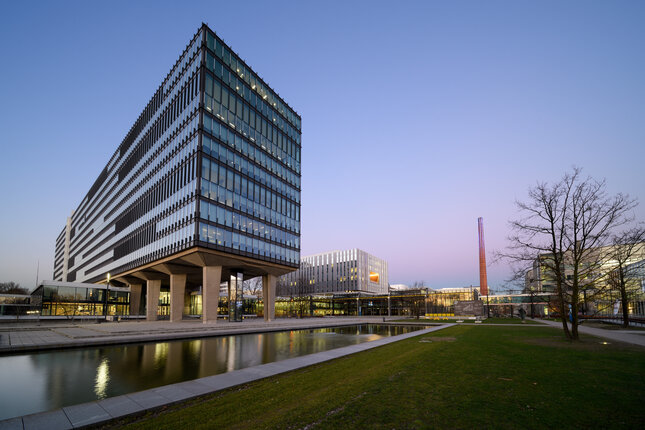
It's the researchers, the research groups, the institutes, and the faculty that set the course.
Rector Silvia Lenaerts
Collaboration
For years, TU Eindhoven has scored high in research done together with the industry. This is not only thanks to the institution's own strategy but also to the character of the Brainport region. But how can the university keep control within that fruitful symbiosis? How do you prevent ASML from setting the course? Lenaerts is adamant: "We decide what research we do and no one else. No company tells us what to do."
"Of course, if there is an opportunity to collaborate with those companies, that is encouraged. However, it is the researchers, the research groups, the institutes, and the faculty that set the course. Academic freedom and institutional autonomy are crucial. Companies want us to go our own way, to think outside the box. After all, that creates real progress and innovation. Companies benefit from research into developments that are further away, developments that they still have limited insight into."
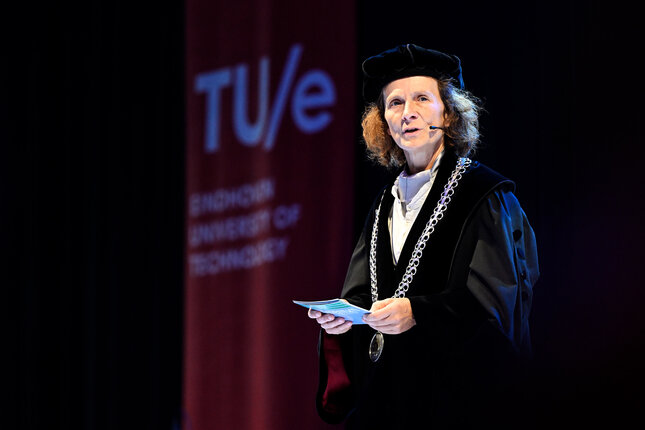
Deal terms
Anyone who wants to become an entrepreneur must experience capturing business interests. In recent years, universities have been working hard on a better Intellectual Property (IP) strategy: how do you protect the IP of researchers, how do you ensure that the university also gets a "fair share" of it, and - last but not least - how do you assure spinoffs of a promising future?
This reassessment was sorely needed; the criticism of "too greedy" universities, including from the start-up world, was not mild. Lenaerts thinks the right path has been taken, and she hears the same from the target audience as well. "With the Revolving Valorization Fund and the adjusted deal terms, we have found more balance."
We are on the right track with our new deal terms regarding intellectual property.
Rector Silvia Lenaerts
"We must not forget that these spinoffs have been able to develop with community money, so it is not so bad that we want some of that value to flow back to the university. But that should be limited in time so that we don't limit their further development. If our stake in such a start-up is so large that it makes it difficult for them to attract new rounds of funding, of course that's not good. With the new deal terms, which have been developed nationwide and we are now fine-tuning for Eindhoven, we are really on the right track."
Becoming aware of IP
Underlying this, according to Lenaerts, there is still a role for the university to make employees more aware of the importance of establishing their property rights. "Not for the university to build an IP portfolio, but to offer our researchers freedom of action."
"They need to know that there are serious consequences if, for example, they give a poster presentation about their research at a conference or give a lecture on it: that means that their ideas can be used directly by others and it becomes impossible to apply for patents on them later. What I just want to point out: this whole IP discussion is mainly in the interest of the researchers themselves, whether they want to start a start-up with it or not."
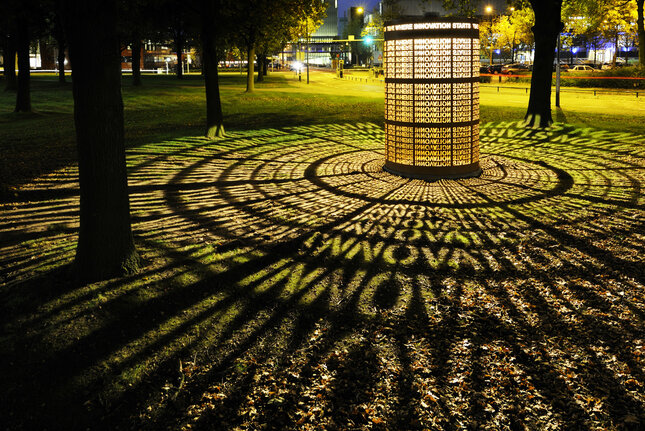
The more contact there is between us and the citizens of Eindhoven, the better we succeed in our valorization mission.
Rector Silvia Lenaerts
Looking outward from her boardroom, Lenaerts calls the TU/e campus a beautiful place for her institution. "And it can only become more beautiful if the plans the city has around KnoopXL are implemented. That means that we will then be even better connected to the rest of the city and our ideal of a university without walls will become even more true."
"That, too, is valorization: opening up as an institution to the world around you. With debates, lectures, contacts with primary and secondary schools, with Studium Generale; the more contact there is between us and the citizens of Eindhoven, the better we succeed in our valorization mission."
This interview was produced in collaboration with The Gate and Innovation Origins.
Media contact
Latest news


![[Translate to English:] Photo: Bart van Overbeeke](https://assets.w3.tue.nl/w/fileadmin/_processed_/e/0/csm_BvOF%202019_1031_BHF%20license%20TUe%20ILI%20copy_8a50884392.jpg)
